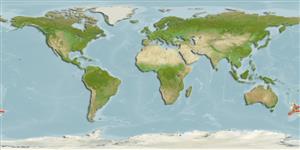Common names from other countries
Classification / Names / Names
Namen | Synonyme | Catalog of Fishes (gen., sp.) | ITIS | CoL | WoRMS
Environment: milieu / climate zone / depth range / distribution range
Ökologie
; tiefenbereich 140 - 640 m (Ref. 4). Temperate; 6°C - 14°C (Ref. 128678), preferred 14°C (Ref. 107945); 33°S - 48°S, 166°E - 173°W (Ref. 4)
Indo-west Pacific: New Zealand and Kermadec Island.
Length at first maturity / Size / Gewicht / Alter
Maturity: Lm 3.4 range ? - ? cm Max length : 25.0 cm TL Männchen/unbestimmt; (Ref. 4); common length : 15.5 cm TL Männchen/unbestimmt; (Ref. 4)
It has a total body length of 25 cm, mostly between 13 and 18 cm (Ref. 4). Prefers mud or sandy mud substrates that are firm enough for burrowing (Refs. 4, 106910) (Ref. 4).
Members of the order Decapoda are mostly gonochoric. Mating behavior: Precopulatory courtship ritual is common (through olfactory and tactile cues); usually indirect sperm transfer.
Holthuis, L.B. 1991. (Ref. 4)
IUCN Rote Liste Status (Ref. 130435)
CITES Status (Ref. 108899)
Not Evaluated
Not Evaluated
Nutzung durch Menschen
Fischereien: kommerziell
FAO - Fischereien: landings | FishSource | Sea Around Us
Tools
Mehr Information
Alter/Größe
Wachstum
Länge-Gewicht
Länge-Länge
Morphologie
Larven
Dichte
Internet Quellen
Estimates based on models
Preferred temperature
(Ref.
115969): 8.6 - 13.4, mean 10.9 (based on 30 cells).
